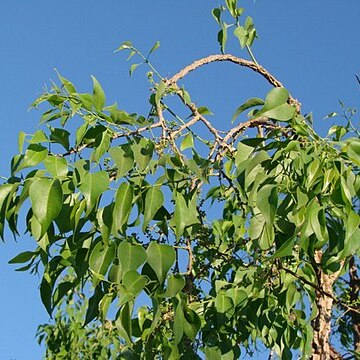Trees to 8 m. tall, the bark rough, brown, the branchlets slender, terete, gla-brous, olive-green. Leaves ovate, 2.5-5.5 cm. long, 2-3 cm. broad, abruptly and briefly acuminate at the apex, obtuse and atenuate at the base, glabrous, the costa plane to immersed above, emersed below, the primary lateral veins prominulous; petiole 3-9 mm. long. Staminate inflorescence 30-to 75-flowered, farinose, the rhachis 3-7 cm. long. Staminate flowers (immature): pedicel about 0.5 mm. long; calyx crateriform, about 0.5 mm. long, farinose, undulate; petals 5, ovate, about 1.5 mm. long, 0.75 mm. broad, farinose without, glabrous within; stamens 5, the filaments 1-2 mm. long, glabrous, the anthers about 0.5 mm. long and broad; disc 5-lobed, the lobes very nearly free, about 0.5 mm. long, fleshy, truncate, obscurely and irregularly lobed at the apex, glabrous; pistillode conical, about 0.75 mm. long, glabrous. Pistillate inflorescences 10-to 15-flowered, farinose, the rhachis 0.5-4.5 cm. long. Pistillate flowers: pedicel 0.5-0.75 mm. long; calyx crateriform, about 0.25 mm. long, farinose without, the margin undulate; petals 4, ovate-trigonal, about 1 mm. long, 0.5 mm. broad at the base, farinose without, indefinitely papillate to glabrous within; disc annular, about 0.25 mm. tall, irregularly lobed to the middle, glabrous; ovary doleiform, 0.5-0.75 mm. long, glabrous, the style obsolete, the stigma 4-lobed. Berry ovoid, 12-15 mm. long, 10-12 mm. in diameter, glabrous; pedicel 5-8 mm. long.
More
Small tree, 3-12(-20) m tall, with thick corky, longitudinally furrowed, pale yellow-grey bark; young branches finely warty to puberulous. Petioles 5-20 mm; blades chartaceous to coriaceous, broadly ovate to narrowly elliptic, 4-9 x 2-5 cm, apex acute to shortly acuminate, base rounded to attenuate, shining above, dull below, primary vein flat above, prominent beneath, secondary veins 6-8 per side, prominulous above and beneath. Racemes axillary, puberulous, male racemes 3-6 cm, female racemes 2-4 cm long; bracts caducous, broadly ovate to rhombic, ca. 2 mm long, upper half with ciliate margin; flowers usually 3 per bract with 2 very small bracteoles at the base of the pedicels of the lateral flowers. Pedicels and flowers puberulous, pedicels 1-2.5 mm long. Male flowers: tepals oblong, acute, 2-3 mm long; stamens 2.5-3.5 mm long, anthers oval, 0.5 mm; disc lobes fleshy, 0.5-0.7 mm long, apex irregularly toothed; rudimentary pistil cylindric, ca. 1 mm long. Female flowers: tepals 0.5 mm long; disc annular, thinly fleshy, up to 0.2 mm high; pistil conical, 0.5 mm long. Drupe 2.3 x 1.7 cm, pedicel up to 10 mm long.
A small tree. It grows about 12 m tall. The bark is thick and corky. The leaves are oval or sword shaped and taper to a short tip. The flowers are in groups in the axils of the small branches. The fruit is yellow and fleshy with a stone inside. It is 12-15 mm long by 10-12 mm wide.


